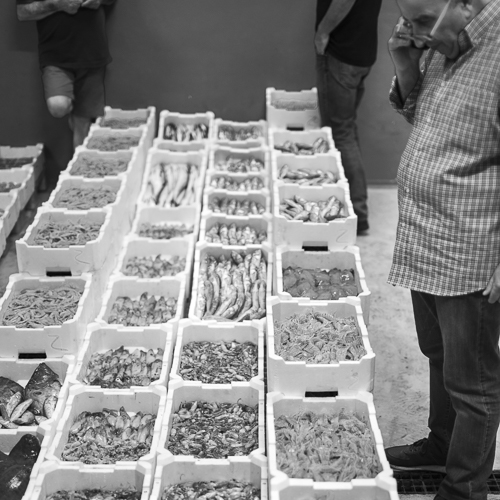Only one fishing boat had moored to the dock below the castle of Porto Ercole when we arrived. The fishermen were busy putting the catch in white styrofoam boxes filled with ice, sorting it according to species and quality. Next, they put the boxes in rows and columns along the pier. In the meantime, a driver reversed a van close to the the pier and opened the doors at the back.
When all the catch had been placed on the pier, the fishermen formed a line and passed the boxes to each other until the last one who put them in the van, while the driver put them in rows and columns inside the van. When they were finished, the driver went to the hall where the auction would take place.
Next, waiting for some time, another fishing boat arrived. A fisherman was standing at the bow, holding a rope with a piece of lead at the end. When the fishing boat was near enough the pier, he threw the rope against the pier where a worker was ready to take it. After some tries, he succeeded in taking it and attaching it to a bollard. Next, the boat reversed, turned around 180 degrees such that the stern was nearest the pier. Finally, it was reversed and when it was near the pier, two fishermen threw ropes with loops at the end towards the pier where two workers attached them to bollards.
Next, the fishermen started sorting the catch in white styrefoam boxes before bringing them to the stern of the ship. There, the same procedure was repeated as was done on the other fishing boat.
Then, we went to the hall, located a few hundred metres from the fishing boats, where the auction should take place. Upon arrival, some workers had sorted the catch on various pallets. When the second catch arrived, they sorted it such that the same type of species was laid next to each other in descending order of quality: first, second and third.
I asked the auctioneer what type of fish had been caught and he told me the following:
- squid
pannocchia (the corresponding name in English is not known)
sole
lobster
crayfish
red mullet
cod
European flying squid
gilthead bream
musky octopus
common octopus
The fishermen go to sea at about 2 in the morning and return at about 7 to 8 in the evening. As we saw at the harbour, after having moored at the pier, they immediately sort the catch and bring it to a van as quickly as possible. This time, they had been fishing near the island of Gianutra and they had been fishing at depths ranging from about 70 m to 200 m.
In the meantime, buyers from Genova, Rome, Naples, etc. were standing around the boxes, studying them attentively, probably thinking about what they wanted to buy and how much they wanted to pay. Being outsiders, we just had to listen to an exchange of jokes, offers and counteroffers between the auctioneer and the buyers. An encounter between offers pronounced between the teeth and short syncopated phrases bouncing between the buyers and the auctioneer at such at quick pace that the fish boxes disappeared and were purchased even before the last ones had been arranged next to each other. Perhaps if the time available was sufficient, we could understand the meaning of this mysterious and important negotiation. However, seafood deteriorates very fast and it’s of utmost importance to reduce the amount of time between fishing and consumption.
An auction of fish is an extreme synthesis of purchase agreement that must be done through gestures, words and decisions with almost lightning speed, a sort of magical ritual that has taken place in the same way for hundreds of years. Anyway, in spite of the speed of the auction, all the data of the seafood is recorded by computer in some central register.
I have been to another seafood auction, which is described here.

